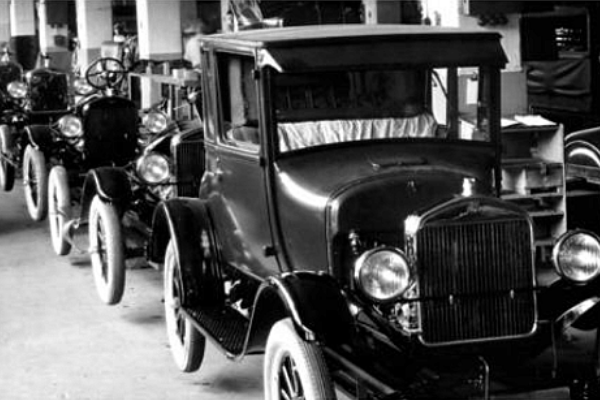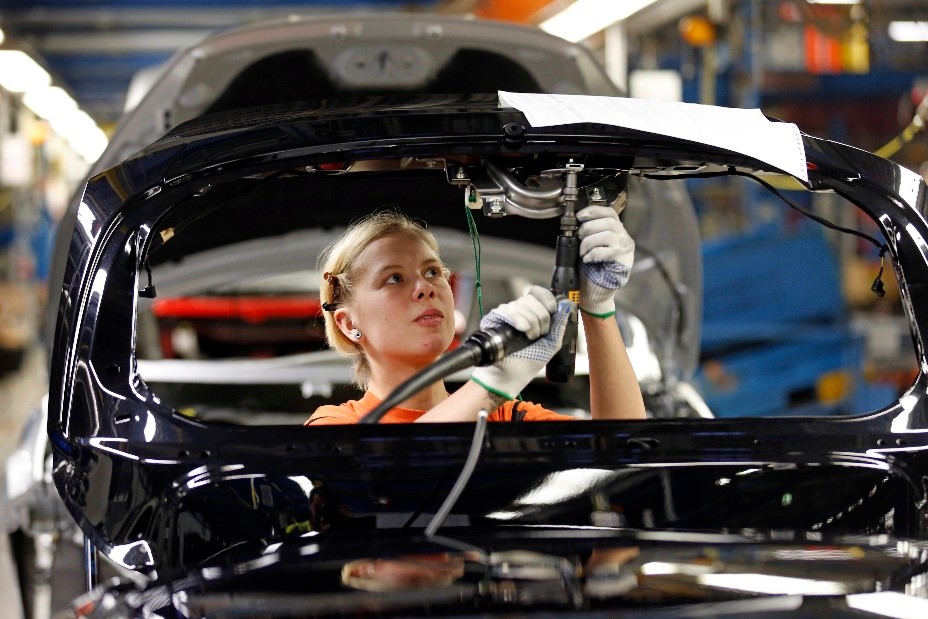Ever since Ransom Olds introduced the automotive assembly line in 1901, and Henry Ford the moving conveyor in 1913 we’ve pretty much been building cars the same way: cramming processes into fixed workstations.
The fixed workstation is a very simple concept. Step 1: define the takt-time based on planned production volume, typically around 60 seconds for high volume. Step 2: set the line speed and workstation size to create 60s workstations. Step 3: divide the assembly process into 60 second groups of tasks to fit the workstations. That’s it. You’re finished.
That worked well for Olds and Ford, but they were building a single model of a simple car. Back then there wasn’t a lot of process variability, and there weren’t any particularly complex processes. That meant you could fairly simply distribute tasks across fixed workstations and then just let the process run.

Today things are very different: a mix of platforms and models are peppered all along the assembly line, each with their own unique set of processes and process timing. Processes are also becoming more complex, with the “it had better fit in a single takt-time” design-for-assembly edict becoming an increasingly unattainable burden. The fixed workstation is beginning to look like a century old relic whose time has come (chiefly because the fixed workstation is a century old relic whose time has come).
It gets worse though: one new worker who isn’t quite up to speed, one batch of parts that are a bit more difficult to align than usual, one model variant that makes you cross-thread a fastener more often than the others and suddenly the end of that workstation is looming in 5 seconds… 4… 3… 2…

Now there’s a choice: stop the line and complete the task (very costly), or let the incomplete car go and finish it later off-line (also very costly).
There must be a better way. Well, there is. Ditch the hard constraints of physical workstations and define your workstations in software. Map out spaces where assembly tasks occur that are infinitely variable and can be altered in real-time – need a 47-second-long takt time? no problem. Have a process that usually takes 80 seconds but sometimes stretches to 90 seconds on some model variants? No problem. Have a new worker that needs 3 more seconds to complete the tasks while getting skilled up? Again, no problem.
It’s possible today to precisely define the workstation areas in virtual 3-dimensional spaces using location intelligence that knows exactly when a car has entered the workstation, where the tool and operator are relative to the car, how long the task is taking and whether an extension is possible or desirable instead of a line stop.
Sound like science fiction? This isn’t even cutting edge anymore – forward thinking automotive manufacturers have been doing this for well over a decade.
As well as taking the stress out of stressed processes, there are more advantages to software-defined workstations.
- Allow workers to work-ahead or catch-up.
- Introduce new product variants without costly line reconfigurations.
- Design overlapping workstations to make the most of the physical space available.
- Enable on-line rework by adding new temporary workstations for remedial tasks
The benefits are manifold. Reduced space for production operations. Reduced wasted idle time between tasks. Reduced line stops. Reduced errors and defects. Reduced time to introduce new models or variants.
All gone in 60 seconds along with the fixed workstation.

Written by Adrian Jennings, Chief Product Advocate at Ubisense
Adrian’s role as a spokesperson for Ubisense takes him all over the world, working with all sorts of organizations, accelerating the adoption of SmartSpace to transform processes. Adrian is a recovering rocket scientist, and as designated UK intelligence expert spent three years as a missile consultant with the US Department of Defence. He received a master’s degree in physics from Oxford University and now finds himself bemusedly working for a Cambridge company.
